Chronic Illness: Interprofessional Person-Centred Care and Nursing
VerifiedAdded on 2023/06/04
|15
|5027
|468
Essay
AI Summary
This essay examines the critical role of nurses in managing chronic illnesses, with a specific focus on lung cancer. It explores the pathophysiology of chronic diseases, emphasizing the impact of symptoms on patients' lives. The essay delves into the importance of patient-centered care, interprofessional collaboration, and self-management strategies in addressing illness prevention and promoting patient well-being. It discusses various treatment modalities, including chemotherapy, radiation therapy, and surgery, while also highlighting the significance of minimizing complications. The essay emphasizes the nurse's role in providing holistic care, including pain management and patient education, to enhance the quality of life for individuals with chronic conditions. The essay also provides an overview of the National Strategic Framework for Chronic Conditions and discusses the importance of trained healthcare professionals in delivering appropriate care. Ultimately, the essay underscores the nurse's pivotal role in empowering patients, promoting healthy behaviors, and improving overall health outcomes within a complex healthcare landscape.

Running head: Chronic illness
Chronic illness
2018
Chronic illness
2018
Paraphrase This Document
Need a fresh take? Get an instant paraphrase of this document with our AI Paraphraser
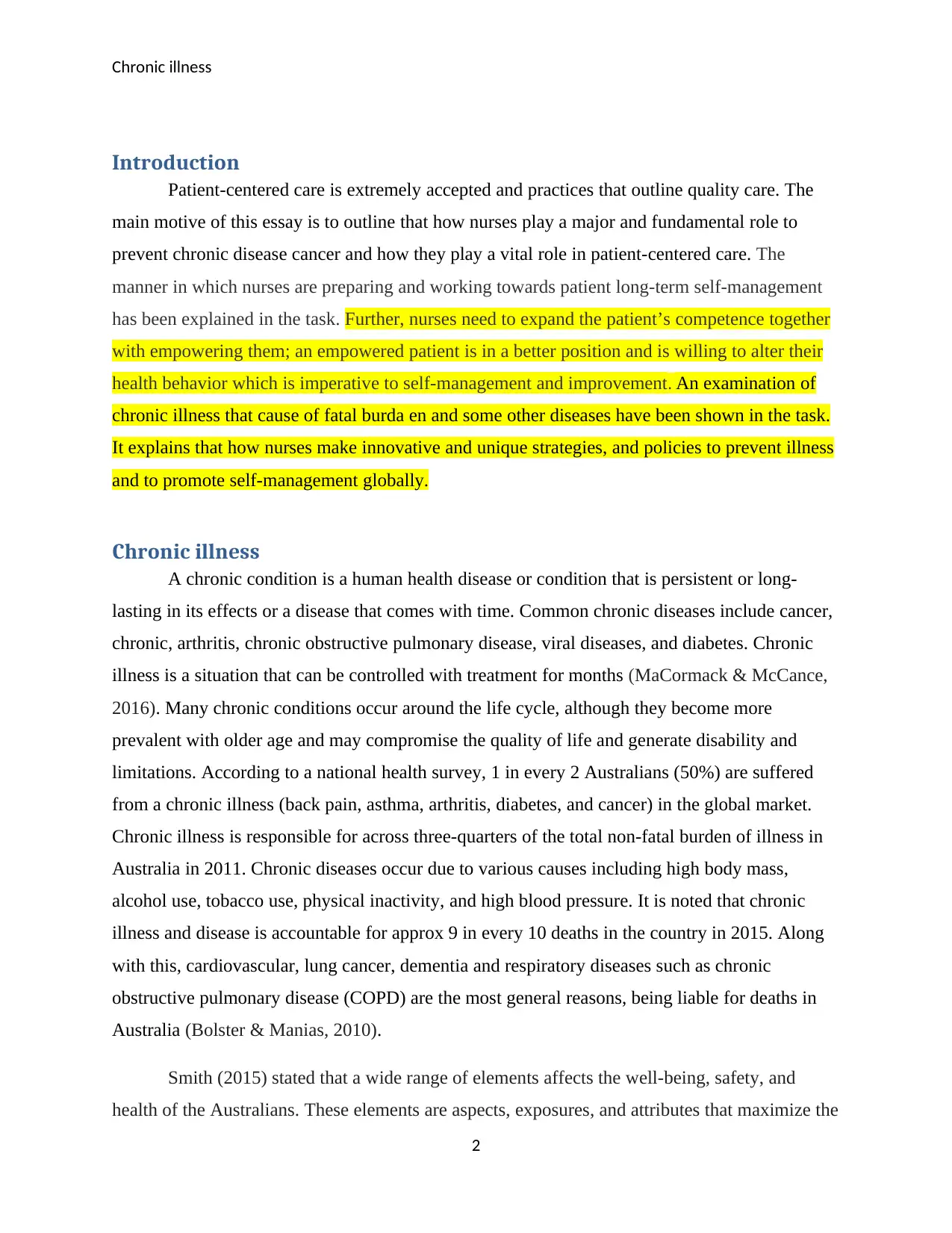
Chronic illness
Introduction
Patient-centered care is extremely accepted and practices that outline quality care. The
main motive of this essay is to outline that how nurses play a major and fundamental role to
prevent chronic disease cancer and how they play a vital role in patient-centered care. The
manner in which nurses are preparing and working towards patient long-term self-management
has been explained in the task. Further, nurses need to expand the patient’s competence together
with empowering them; an empowered patient is in a better position and is willing to alter their
health behavior which is imperative to self-management and improvement. An examination of
chronic illness that cause of fatal burda en and some other diseases have been shown in the task.
It explains that how nurses make innovative and unique strategies, and policies to prevent illness
and to promote self-management globally.
Chronic illness
A chronic condition is a human health disease or condition that is persistent or long-
lasting in its effects or a disease that comes with time. Common chronic diseases include cancer,
chronic, arthritis, chronic obstructive pulmonary disease, viral diseases, and diabetes. Chronic
illness is a situation that can be controlled with treatment for months (MaCormack & McCance,
2016). Many chronic conditions occur around the life cycle, although they become more
prevalent with older age and may compromise the quality of life and generate disability and
limitations. According to a national health survey, 1 in every 2 Australians (50%) are suffered
from a chronic illness (back pain, asthma, arthritis, diabetes, and cancer) in the global market.
Chronic illness is responsible for across three-quarters of the total non-fatal burden of illness in
Australia in 2011. Chronic diseases occur due to various causes including high body mass,
alcohol use, tobacco use, physical inactivity, and high blood pressure. It is noted that chronic
illness and disease is accountable for approx 9 in every 10 deaths in the country in 2015. Along
with this, cardiovascular, lung cancer, dementia and respiratory diseases such as chronic
obstructive pulmonary disease (COPD) are the most general reasons, being liable for deaths in
Australia (Bolster & Manias, 2010).
Smith (2015) stated that a wide range of elements affects the well-being, safety, and
health of the Australians. These elements are aspects, exposures, and attributes that maximize the
2
Introduction
Patient-centered care is extremely accepted and practices that outline quality care. The
main motive of this essay is to outline that how nurses play a major and fundamental role to
prevent chronic disease cancer and how they play a vital role in patient-centered care. The
manner in which nurses are preparing and working towards patient long-term self-management
has been explained in the task. Further, nurses need to expand the patient’s competence together
with empowering them; an empowered patient is in a better position and is willing to alter their
health behavior which is imperative to self-management and improvement. An examination of
chronic illness that cause of fatal burda en and some other diseases have been shown in the task.
It explains that how nurses make innovative and unique strategies, and policies to prevent illness
and to promote self-management globally.
Chronic illness
A chronic condition is a human health disease or condition that is persistent or long-
lasting in its effects or a disease that comes with time. Common chronic diseases include cancer,
chronic, arthritis, chronic obstructive pulmonary disease, viral diseases, and diabetes. Chronic
illness is a situation that can be controlled with treatment for months (MaCormack & McCance,
2016). Many chronic conditions occur around the life cycle, although they become more
prevalent with older age and may compromise the quality of life and generate disability and
limitations. According to a national health survey, 1 in every 2 Australians (50%) are suffered
from a chronic illness (back pain, asthma, arthritis, diabetes, and cancer) in the global market.
Chronic illness is responsible for across three-quarters of the total non-fatal burden of illness in
Australia in 2011. Chronic diseases occur due to various causes including high body mass,
alcohol use, tobacco use, physical inactivity, and high blood pressure. It is noted that chronic
illness and disease is accountable for approx 9 in every 10 deaths in the country in 2015. Along
with this, cardiovascular, lung cancer, dementia and respiratory diseases such as chronic
obstructive pulmonary disease (COPD) are the most general reasons, being liable for deaths in
Australia (Bolster & Manias, 2010).
Smith (2015) stated that a wide range of elements affects the well-being, safety, and
health of the Australians. These elements are aspects, exposures, and attributes that maximize the
2
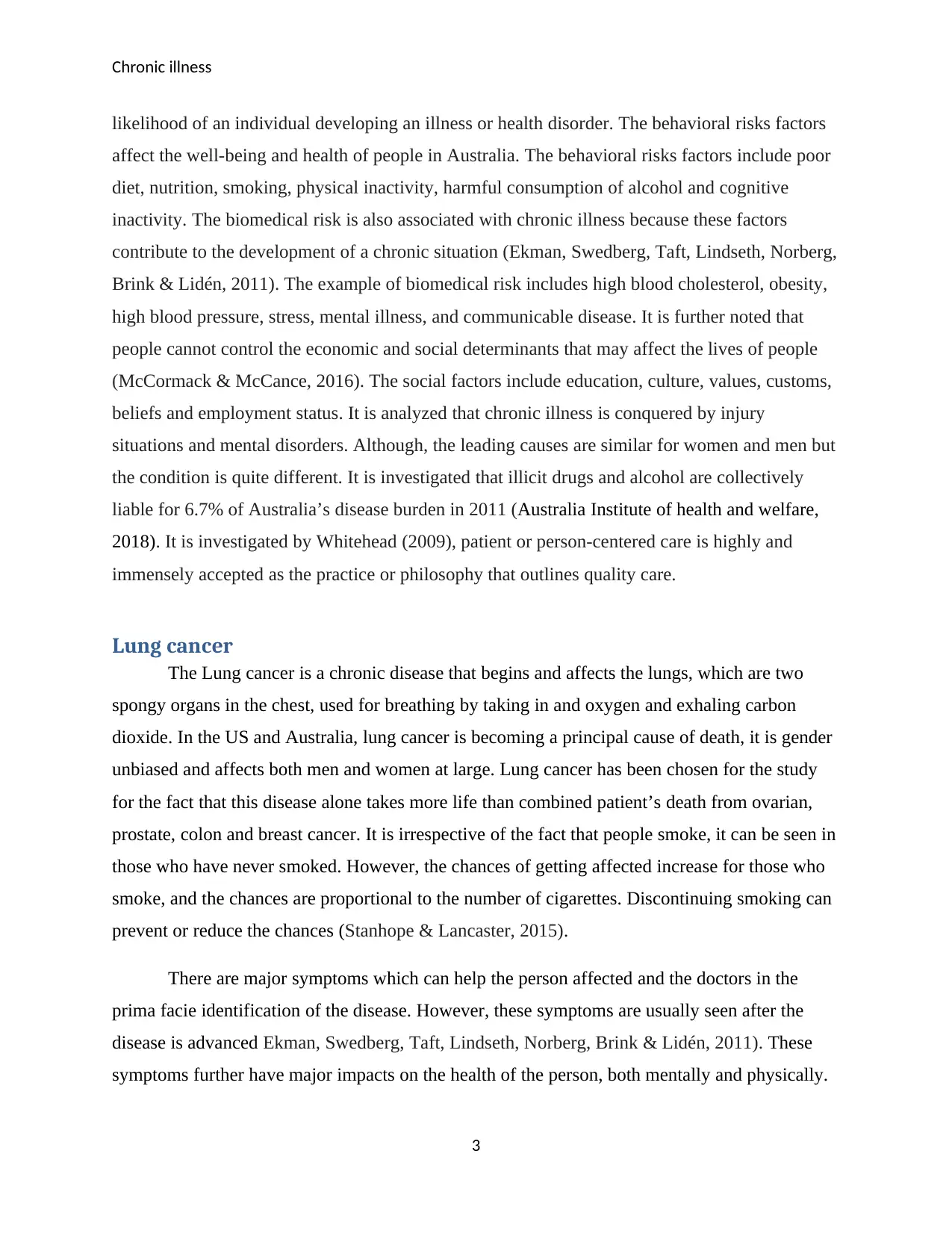
Chronic illness
likelihood of an individual developing an illness or health disorder. The behavioral risks factors
affect the well-being and health of people in Australia. The behavioral risks factors include poor
diet, nutrition, smoking, physical inactivity, harmful consumption of alcohol and cognitive
inactivity. The biomedical risk is also associated with chronic illness because these factors
contribute to the development of a chronic situation (Ekman, Swedberg, Taft, Lindseth, Norberg,
Brink & Lidén, 2011). The example of biomedical risk includes high blood cholesterol, obesity,
high blood pressure, stress, mental illness, and communicable disease. It is further noted that
people cannot control the economic and social determinants that may affect the lives of people
(McCormack & McCance, 2016). The social factors include education, culture, values, customs,
beliefs and employment status. It is analyzed that chronic illness is conquered by injury
situations and mental disorders. Although, the leading causes are similar for women and men but
the condition is quite different. It is investigated that illicit drugs and alcohol are collectively
liable for 6.7% of Australia’s disease burden in 2011 (Australia Institute of health and welfare,
2018). It is investigated by Whitehead (2009), patient or person-centered care is highly and
immensely accepted as the practice or philosophy that outlines quality care.
Lung cancer
The Lung cancer is a chronic disease that begins and affects the lungs, which are two
spongy organs in the chest, used for breathing by taking in and oxygen and exhaling carbon
dioxide. In the US and Australia, lung cancer is becoming a principal cause of death, it is gender
unbiased and affects both men and women at large. Lung cancer has been chosen for the study
for the fact that this disease alone takes more life than combined patient’s death from ovarian,
prostate, colon and breast cancer. It is irrespective of the fact that people smoke, it can be seen in
those who have never smoked. However, the chances of getting affected increase for those who
smoke, and the chances are proportional to the number of cigarettes. Discontinuing smoking can
prevent or reduce the chances (Stanhope & Lancaster, 2015).
There are major symptoms which can help the person affected and the doctors in the
prima facie identification of the disease. However, these symptoms are usually seen after the
disease is advanced Ekman, Swedberg, Taft, Lindseth, Norberg, Brink & Lidén, 2011). These
symptoms further have major impacts on the health of the person, both mentally and physically.
3
likelihood of an individual developing an illness or health disorder. The behavioral risks factors
affect the well-being and health of people in Australia. The behavioral risks factors include poor
diet, nutrition, smoking, physical inactivity, harmful consumption of alcohol and cognitive
inactivity. The biomedical risk is also associated with chronic illness because these factors
contribute to the development of a chronic situation (Ekman, Swedberg, Taft, Lindseth, Norberg,
Brink & Lidén, 2011). The example of biomedical risk includes high blood cholesterol, obesity,
high blood pressure, stress, mental illness, and communicable disease. It is further noted that
people cannot control the economic and social determinants that may affect the lives of people
(McCormack & McCance, 2016). The social factors include education, culture, values, customs,
beliefs and employment status. It is analyzed that chronic illness is conquered by injury
situations and mental disorders. Although, the leading causes are similar for women and men but
the condition is quite different. It is investigated that illicit drugs and alcohol are collectively
liable for 6.7% of Australia’s disease burden in 2011 (Australia Institute of health and welfare,
2018). It is investigated by Whitehead (2009), patient or person-centered care is highly and
immensely accepted as the practice or philosophy that outlines quality care.
Lung cancer
The Lung cancer is a chronic disease that begins and affects the lungs, which are two
spongy organs in the chest, used for breathing by taking in and oxygen and exhaling carbon
dioxide. In the US and Australia, lung cancer is becoming a principal cause of death, it is gender
unbiased and affects both men and women at large. Lung cancer has been chosen for the study
for the fact that this disease alone takes more life than combined patient’s death from ovarian,
prostate, colon and breast cancer. It is irrespective of the fact that people smoke, it can be seen in
those who have never smoked. However, the chances of getting affected increase for those who
smoke, and the chances are proportional to the number of cigarettes. Discontinuing smoking can
prevent or reduce the chances (Stanhope & Lancaster, 2015).
There are major symptoms which can help the person affected and the doctors in the
prima facie identification of the disease. However, these symptoms are usually seen after the
disease is advanced Ekman, Swedberg, Taft, Lindseth, Norberg, Brink & Lidén, 2011). These
symptoms further have major impacts on the health of the person, both mentally and physically.
3
⊘ This is a preview!⊘
Do you want full access?
Subscribe today to unlock all pages.

Trusted by 1+ million students worldwide
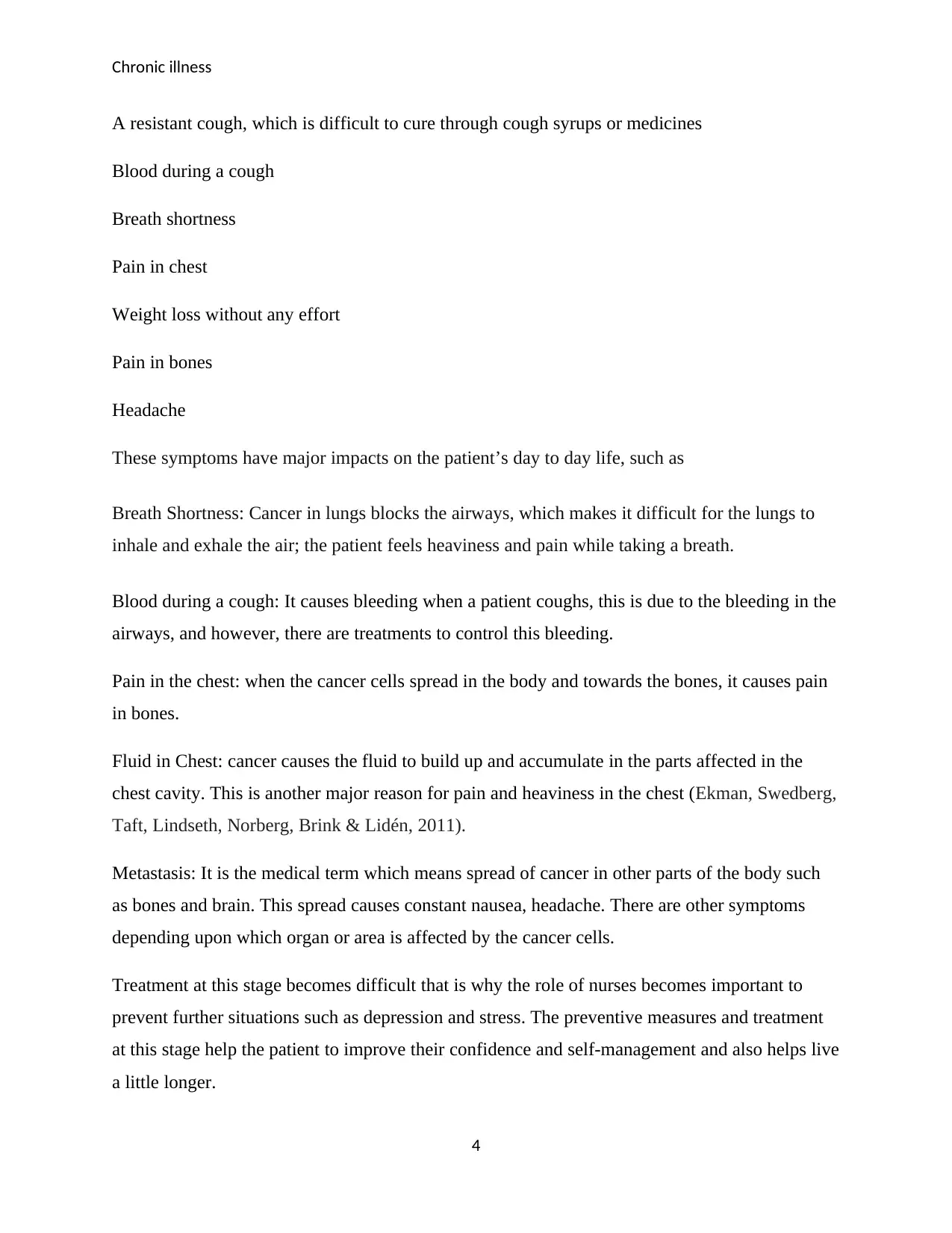
Chronic illness
A resistant cough, which is difficult to cure through cough syrups or medicines
Blood during a cough
Breath shortness
Pain in chest
Weight loss without any effort
Pain in bones
Headache
These symptoms have major impacts on the patient’s day to day life, such as
Breath Shortness: Cancer in lungs blocks the airways, which makes it difficult for the lungs to
inhale and exhale the air; the patient feels heaviness and pain while taking a breath.
Blood during a cough: It causes bleeding when a patient coughs, this is due to the bleeding in the
airways, and however, there are treatments to control this bleeding.
Pain in the chest: when the cancer cells spread in the body and towards the bones, it causes pain
in bones.
Fluid in Chest: cancer causes the fluid to build up and accumulate in the parts affected in the
chest cavity. This is another major reason for pain and heaviness in the chest (Ekman, Swedberg,
Taft, Lindseth, Norberg, Brink & Lidén, 2011).
Metastasis: It is the medical term which means spread of cancer in other parts of the body such
as bones and brain. This spread causes constant nausea, headache. There are other symptoms
depending upon which organ or area is affected by the cancer cells.
Treatment at this stage becomes difficult that is why the role of nurses becomes important to
prevent further situations such as depression and stress. The preventive measures and treatment
at this stage help the patient to improve their confidence and self-management and also helps live
a little longer.
4
A resistant cough, which is difficult to cure through cough syrups or medicines
Blood during a cough
Breath shortness
Pain in chest
Weight loss without any effort
Pain in bones
Headache
These symptoms have major impacts on the patient’s day to day life, such as
Breath Shortness: Cancer in lungs blocks the airways, which makes it difficult for the lungs to
inhale and exhale the air; the patient feels heaviness and pain while taking a breath.
Blood during a cough: It causes bleeding when a patient coughs, this is due to the bleeding in the
airways, and however, there are treatments to control this bleeding.
Pain in the chest: when the cancer cells spread in the body and towards the bones, it causes pain
in bones.
Fluid in Chest: cancer causes the fluid to build up and accumulate in the parts affected in the
chest cavity. This is another major reason for pain and heaviness in the chest (Ekman, Swedberg,
Taft, Lindseth, Norberg, Brink & Lidén, 2011).
Metastasis: It is the medical term which means spread of cancer in other parts of the body such
as bones and brain. This spread causes constant nausea, headache. There are other symptoms
depending upon which organ or area is affected by the cancer cells.
Treatment at this stage becomes difficult that is why the role of nurses becomes important to
prevent further situations such as depression and stress. The preventive measures and treatment
at this stage help the patient to improve their confidence and self-management and also helps live
a little longer.
4
Paraphrase This Document
Need a fresh take? Get an instant paraphrase of this document with our AI Paraphraser
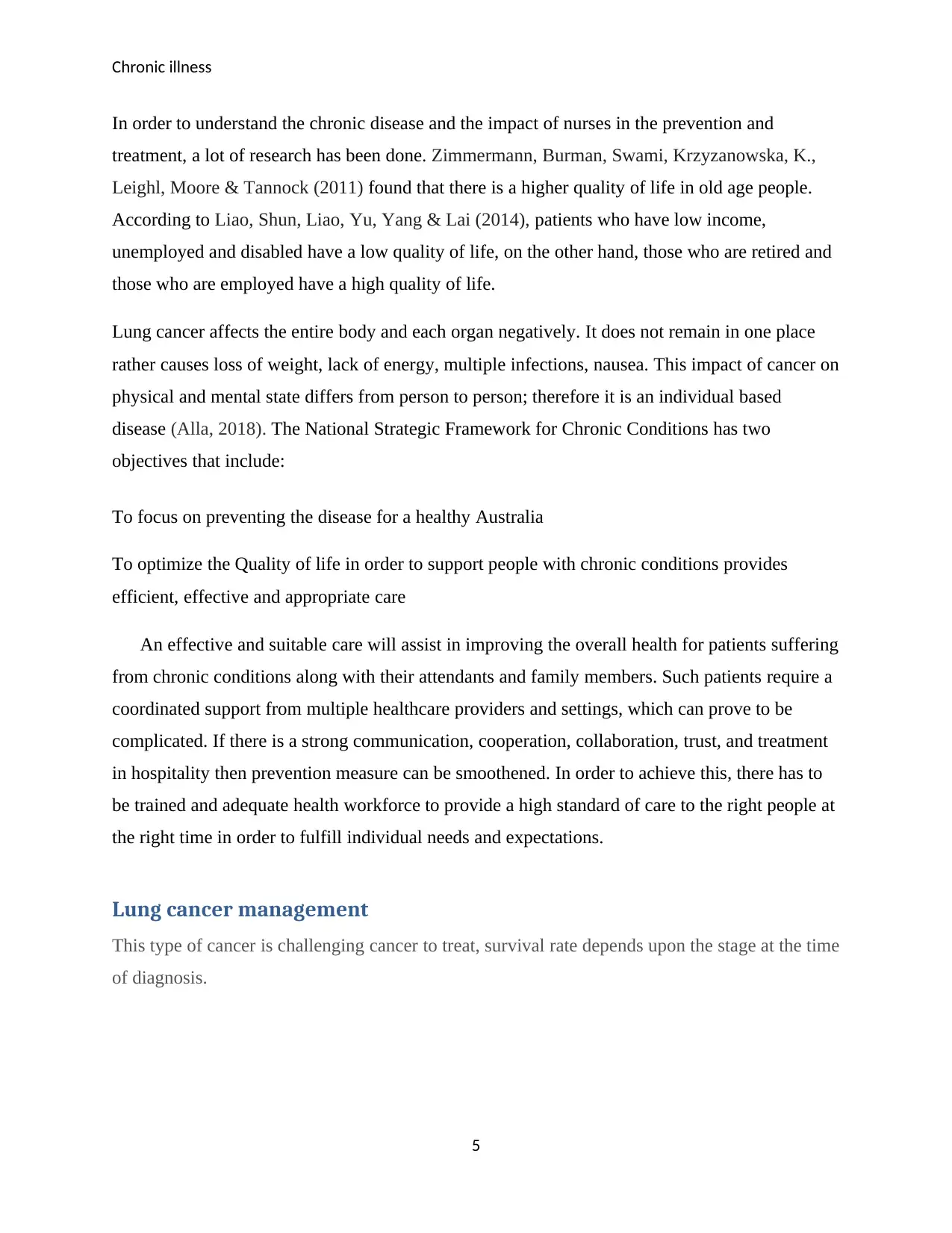
Chronic illness
In order to understand the chronic disease and the impact of nurses in the prevention and
treatment, a lot of research has been done. Zimmermann, Burman, Swami, Krzyzanowska, K.,
Leighl, Moore & Tannock (2011) found that there is a higher quality of life in old age people.
According to Liao, Shun, Liao, Yu, Yang & Lai (2014), patients who have low income,
unemployed and disabled have a low quality of life, on the other hand, those who are retired and
those who are employed have a high quality of life.
Lung cancer affects the entire body and each organ negatively. It does not remain in one place
rather causes loss of weight, lack of energy, multiple infections, nausea. This impact of cancer on
physical and mental state differs from person to person; therefore it is an individual based
disease (Alla, 2018). The National Strategic Framework for Chronic Conditions has two
objectives that include:
To focus on preventing the disease for a healthy Australia
To optimize the Quality of life in order to support people with chronic conditions provides
efficient, effective and appropriate care
An effective and suitable care will assist in improving the overall health for patients suffering
from chronic conditions along with their attendants and family members. Such patients require a
coordinated support from multiple healthcare providers and settings, which can prove to be
complicated. If there is a strong communication, cooperation, collaboration, trust, and treatment
in hospitality then prevention measure can be smoothened. In order to achieve this, there has to
be trained and adequate health workforce to provide a high standard of care to the right people at
the right time in order to fulfill individual needs and expectations.
Lung cancer management
This type of cancer is challenging cancer to treat, survival rate depends upon the stage at the time
of diagnosis.
5
In order to understand the chronic disease and the impact of nurses in the prevention and
treatment, a lot of research has been done. Zimmermann, Burman, Swami, Krzyzanowska, K.,
Leighl, Moore & Tannock (2011) found that there is a higher quality of life in old age people.
According to Liao, Shun, Liao, Yu, Yang & Lai (2014), patients who have low income,
unemployed and disabled have a low quality of life, on the other hand, those who are retired and
those who are employed have a high quality of life.
Lung cancer affects the entire body and each organ negatively. It does not remain in one place
rather causes loss of weight, lack of energy, multiple infections, nausea. This impact of cancer on
physical and mental state differs from person to person; therefore it is an individual based
disease (Alla, 2018). The National Strategic Framework for Chronic Conditions has two
objectives that include:
To focus on preventing the disease for a healthy Australia
To optimize the Quality of life in order to support people with chronic conditions provides
efficient, effective and appropriate care
An effective and suitable care will assist in improving the overall health for patients suffering
from chronic conditions along with their attendants and family members. Such patients require a
coordinated support from multiple healthcare providers and settings, which can prove to be
complicated. If there is a strong communication, cooperation, collaboration, trust, and treatment
in hospitality then prevention measure can be smoothened. In order to achieve this, there has to
be trained and adequate health workforce to provide a high standard of care to the right people at
the right time in order to fulfill individual needs and expectations.
Lung cancer management
This type of cancer is challenging cancer to treat, survival rate depends upon the stage at the time
of diagnosis.
5

Chronic illness
(Source: https://www.abc.net.au/news/2018-10-24/one-in-five-with-lung-cancer-receive-no-treatment-
at-all-report/10403042)
The management includes the following mode of treatments
1. Chemotherapy is one way in which with the use of drugs the rapidly growing cancer cells
in the body are killed. In therapy, either it is directly injected or medical team uses a
catheter. This affects both the normal as well as the cancer cells, the side effect depends
upon the type and amount of drug used.
2. Radiation therapy is the primary therapy used alone or along with chemotherapy, to kill
the cancer cells using X-ray. It soothes the pain, airway blockage and coughing. Side
effect depends upon the body part and amount of radiation (Collins, Haines, Perkel &
Enck, 2007).
3. Surgery is the primary alternative mostly used during the first stage diagnosis. The tumor
is removed along with the surrounding issues. It is only beneficial when the cancer cells
are still located in one place.
4. Pulmonary rehabilitation is the programs used for patients affected from chronic diseases.
Due to such diseases, the quality of life and health is affected. These programs provide
knowledge and education to the patients for their recovery and to improve and manage
their conditions.
5. Pain Management is done through multiple intervention programs because apart from the
medications and therapies, cancer itself is a cause of physical and mental pain. Therefore,
6
(Source: https://www.abc.net.au/news/2018-10-24/one-in-five-with-lung-cancer-receive-no-treatment-
at-all-report/10403042)
The management includes the following mode of treatments
1. Chemotherapy is one way in which with the use of drugs the rapidly growing cancer cells
in the body are killed. In therapy, either it is directly injected or medical team uses a
catheter. This affects both the normal as well as the cancer cells, the side effect depends
upon the type and amount of drug used.
2. Radiation therapy is the primary therapy used alone or along with chemotherapy, to kill
the cancer cells using X-ray. It soothes the pain, airway blockage and coughing. Side
effect depends upon the body part and amount of radiation (Collins, Haines, Perkel &
Enck, 2007).
3. Surgery is the primary alternative mostly used during the first stage diagnosis. The tumor
is removed along with the surrounding issues. It is only beneficial when the cancer cells
are still located in one place.
4. Pulmonary rehabilitation is the programs used for patients affected from chronic diseases.
Due to such diseases, the quality of life and health is affected. These programs provide
knowledge and education to the patients for their recovery and to improve and manage
their conditions.
5. Pain Management is done through multiple intervention programs because apart from the
medications and therapies, cancer itself is a cause of physical and mental pain. Therefore,
6
⊘ This is a preview!⊘
Do you want full access?
Subscribe today to unlock all pages.

Trusted by 1+ million students worldwide
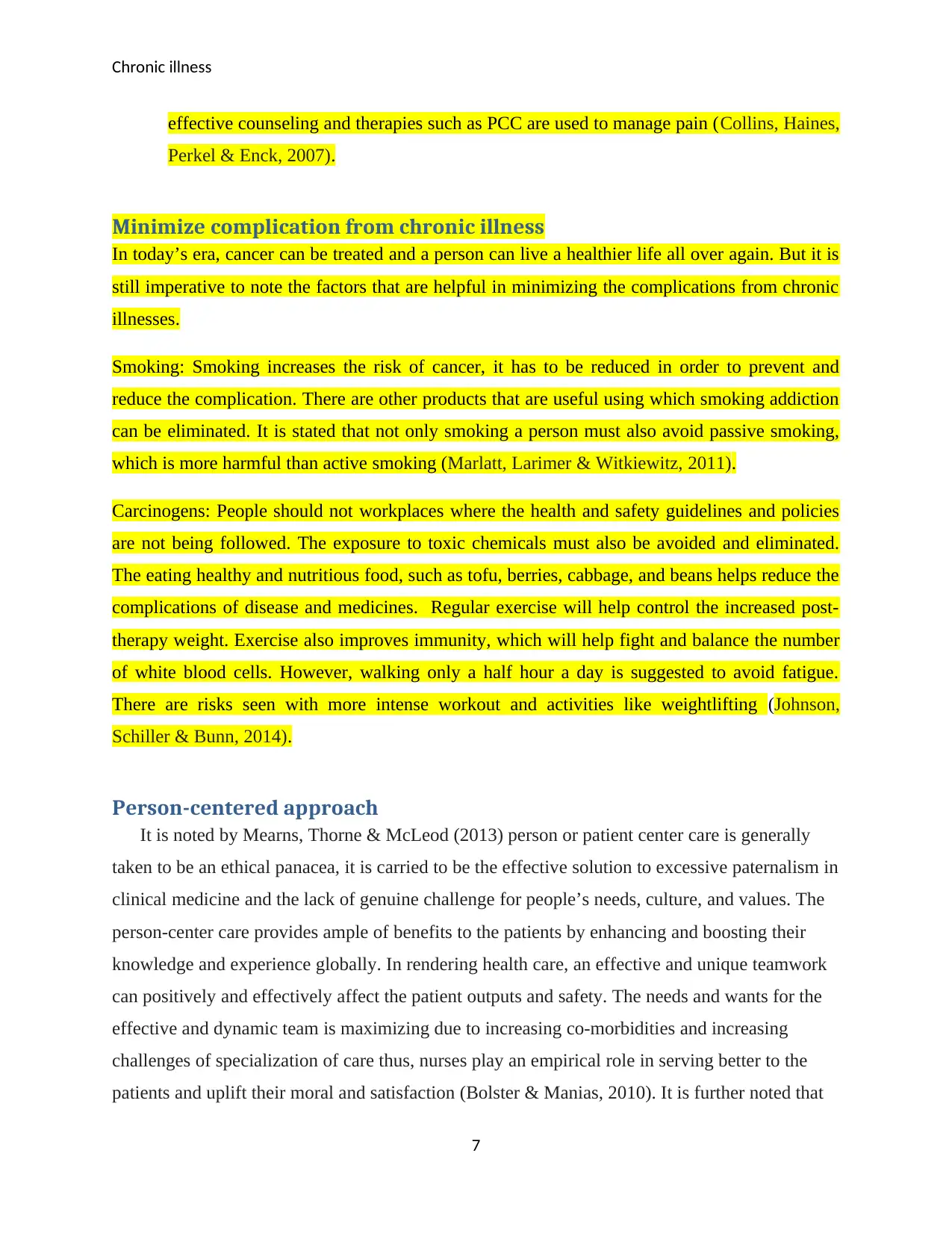
Chronic illness
effective counseling and therapies such as PCC are used to manage pain (Collins, Haines,
Perkel & Enck, 2007).
Minimize complication from chronic illness
In today’s era, cancer can be treated and a person can live a healthier life all over again. But it is
still imperative to note the factors that are helpful in minimizing the complications from chronic
illnesses.
Smoking: Smoking increases the risk of cancer, it has to be reduced in order to prevent and
reduce the complication. There are other products that are useful using which smoking addiction
can be eliminated. It is stated that not only smoking a person must also avoid passive smoking,
which is more harmful than active smoking (Marlatt, Larimer & Witkiewitz, 2011).
Carcinogens: People should not workplaces where the health and safety guidelines and policies
are not being followed. The exposure to toxic chemicals must also be avoided and eliminated.
The eating healthy and nutritious food, such as tofu, berries, cabbage, and beans helps reduce the
complications of disease and medicines. Regular exercise will help control the increased post-
therapy weight. Exercise also improves immunity, which will help fight and balance the number
of white blood cells. However, walking only a half hour a day is suggested to avoid fatigue.
There are risks seen with more intense workout and activities like weightlifting (Johnson,
Schiller & Bunn, 2014).
Person-centered approach
It is noted by Mearns, Thorne & McLeod (2013) person or patient center care is generally
taken to be an ethical panacea, it is carried to be the effective solution to excessive paternalism in
clinical medicine and the lack of genuine challenge for people’s needs, culture, and values. The
person-center care provides ample of benefits to the patients by enhancing and boosting their
knowledge and experience globally. In rendering health care, an effective and unique teamwork
can positively and effectively affect the patient outputs and safety. The needs and wants for the
effective and dynamic team is maximizing due to increasing co-morbidities and increasing
challenges of specialization of care thus, nurses play an empirical role in serving better to the
patients and uplift their moral and satisfaction (Bolster & Manias, 2010). It is further noted that
7
effective counseling and therapies such as PCC are used to manage pain (Collins, Haines,
Perkel & Enck, 2007).
Minimize complication from chronic illness
In today’s era, cancer can be treated and a person can live a healthier life all over again. But it is
still imperative to note the factors that are helpful in minimizing the complications from chronic
illnesses.
Smoking: Smoking increases the risk of cancer, it has to be reduced in order to prevent and
reduce the complication. There are other products that are useful using which smoking addiction
can be eliminated. It is stated that not only smoking a person must also avoid passive smoking,
which is more harmful than active smoking (Marlatt, Larimer & Witkiewitz, 2011).
Carcinogens: People should not workplaces where the health and safety guidelines and policies
are not being followed. The exposure to toxic chemicals must also be avoided and eliminated.
The eating healthy and nutritious food, such as tofu, berries, cabbage, and beans helps reduce the
complications of disease and medicines. Regular exercise will help control the increased post-
therapy weight. Exercise also improves immunity, which will help fight and balance the number
of white blood cells. However, walking only a half hour a day is suggested to avoid fatigue.
There are risks seen with more intense workout and activities like weightlifting (Johnson,
Schiller & Bunn, 2014).
Person-centered approach
It is noted by Mearns, Thorne & McLeod (2013) person or patient center care is generally
taken to be an ethical panacea, it is carried to be the effective solution to excessive paternalism in
clinical medicine and the lack of genuine challenge for people’s needs, culture, and values. The
person-center care provides ample of benefits to the patients by enhancing and boosting their
knowledge and experience globally. In rendering health care, an effective and unique teamwork
can positively and effectively affect the patient outputs and safety. The needs and wants for the
effective and dynamic team is maximizing due to increasing co-morbidities and increasing
challenges of specialization of care thus, nurses play an empirical role in serving better to the
patients and uplift their moral and satisfaction (Bolster & Manias, 2010). It is further noted that
7
Paraphrase This Document
Need a fresh take? Get an instant paraphrase of this document with our AI Paraphraser
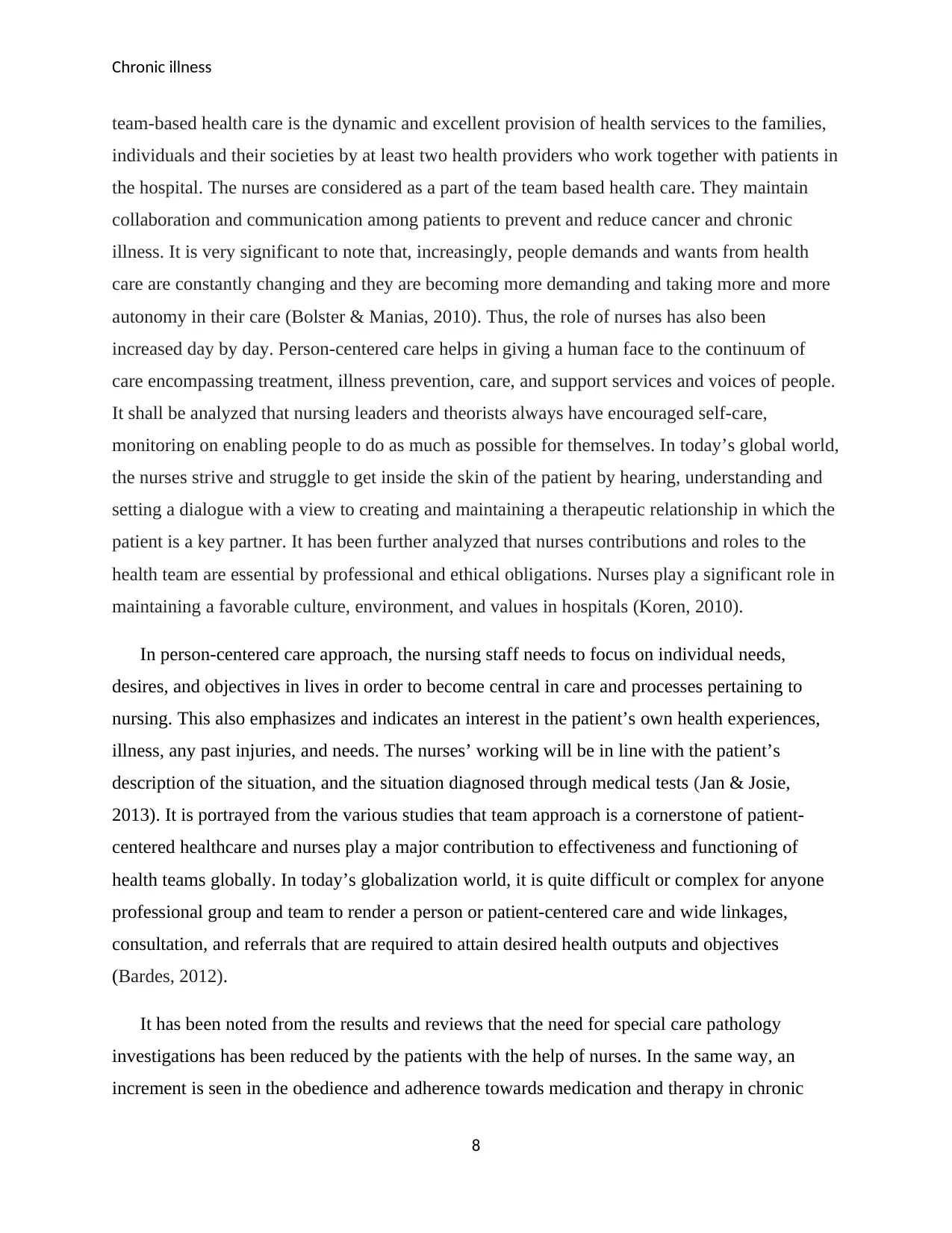
Chronic illness
team-based health care is the dynamic and excellent provision of health services to the families,
individuals and their societies by at least two health providers who work together with patients in
the hospital. The nurses are considered as a part of the team based health care. They maintain
collaboration and communication among patients to prevent and reduce cancer and chronic
illness. It is very significant to note that, increasingly, people demands and wants from health
care are constantly changing and they are becoming more demanding and taking more and more
autonomy in their care (Bolster & Manias, 2010). Thus, the role of nurses has also been
increased day by day. Person-centered care helps in giving a human face to the continuum of
care encompassing treatment, illness prevention, care, and support services and voices of people.
It shall be analyzed that nursing leaders and theorists always have encouraged self-care,
monitoring on enabling people to do as much as possible for themselves. In today’s global world,
the nurses strive and struggle to get inside the skin of the patient by hearing, understanding and
setting a dialogue with a view to creating and maintaining a therapeutic relationship in which the
patient is a key partner. It has been further analyzed that nurses contributions and roles to the
health team are essential by professional and ethical obligations. Nurses play a significant role in
maintaining a favorable culture, environment, and values in hospitals (Koren, 2010).
In person-centered care approach, the nursing staff needs to focus on individual needs,
desires, and objectives in lives in order to become central in care and processes pertaining to
nursing. This also emphasizes and indicates an interest in the patient’s own health experiences,
illness, any past injuries, and needs. The nurses’ working will be in line with the patient’s
description of the situation, and the situation diagnosed through medical tests (Jan & Josie,
2013). It is portrayed from the various studies that team approach is a cornerstone of patient-
centered healthcare and nurses play a major contribution to effectiveness and functioning of
health teams globally. In today’s globalization world, it is quite difficult or complex for anyone
professional group and team to render a person or patient-centered care and wide linkages,
consultation, and referrals that are required to attain desired health outputs and objectives
(Bardes, 2012).
It has been noted from the results and reviews that the need for special care pathology
investigations has been reduced by the patients with the help of nurses. In the same way, an
increment is seen in the obedience and adherence towards medication and therapy in chronic
8
team-based health care is the dynamic and excellent provision of health services to the families,
individuals and their societies by at least two health providers who work together with patients in
the hospital. The nurses are considered as a part of the team based health care. They maintain
collaboration and communication among patients to prevent and reduce cancer and chronic
illness. It is very significant to note that, increasingly, people demands and wants from health
care are constantly changing and they are becoming more demanding and taking more and more
autonomy in their care (Bolster & Manias, 2010). Thus, the role of nurses has also been
increased day by day. Person-centered care helps in giving a human face to the continuum of
care encompassing treatment, illness prevention, care, and support services and voices of people.
It shall be analyzed that nursing leaders and theorists always have encouraged self-care,
monitoring on enabling people to do as much as possible for themselves. In today’s global world,
the nurses strive and struggle to get inside the skin of the patient by hearing, understanding and
setting a dialogue with a view to creating and maintaining a therapeutic relationship in which the
patient is a key partner. It has been further analyzed that nurses contributions and roles to the
health team are essential by professional and ethical obligations. Nurses play a significant role in
maintaining a favorable culture, environment, and values in hospitals (Koren, 2010).
In person-centered care approach, the nursing staff needs to focus on individual needs,
desires, and objectives in lives in order to become central in care and processes pertaining to
nursing. This also emphasizes and indicates an interest in the patient’s own health experiences,
illness, any past injuries, and needs. The nurses’ working will be in line with the patient’s
description of the situation, and the situation diagnosed through medical tests (Jan & Josie,
2013). It is portrayed from the various studies that team approach is a cornerstone of patient-
centered healthcare and nurses play a major contribution to effectiveness and functioning of
health teams globally. In today’s globalization world, it is quite difficult or complex for anyone
professional group and team to render a person or patient-centered care and wide linkages,
consultation, and referrals that are required to attain desired health outputs and objectives
(Bardes, 2012).
It has been noted from the results and reviews that the need for special care pathology
investigations has been reduced by the patients with the help of nurses. In the same way, an
increment is seen in the obedience and adherence towards medication and therapy in chronic
8
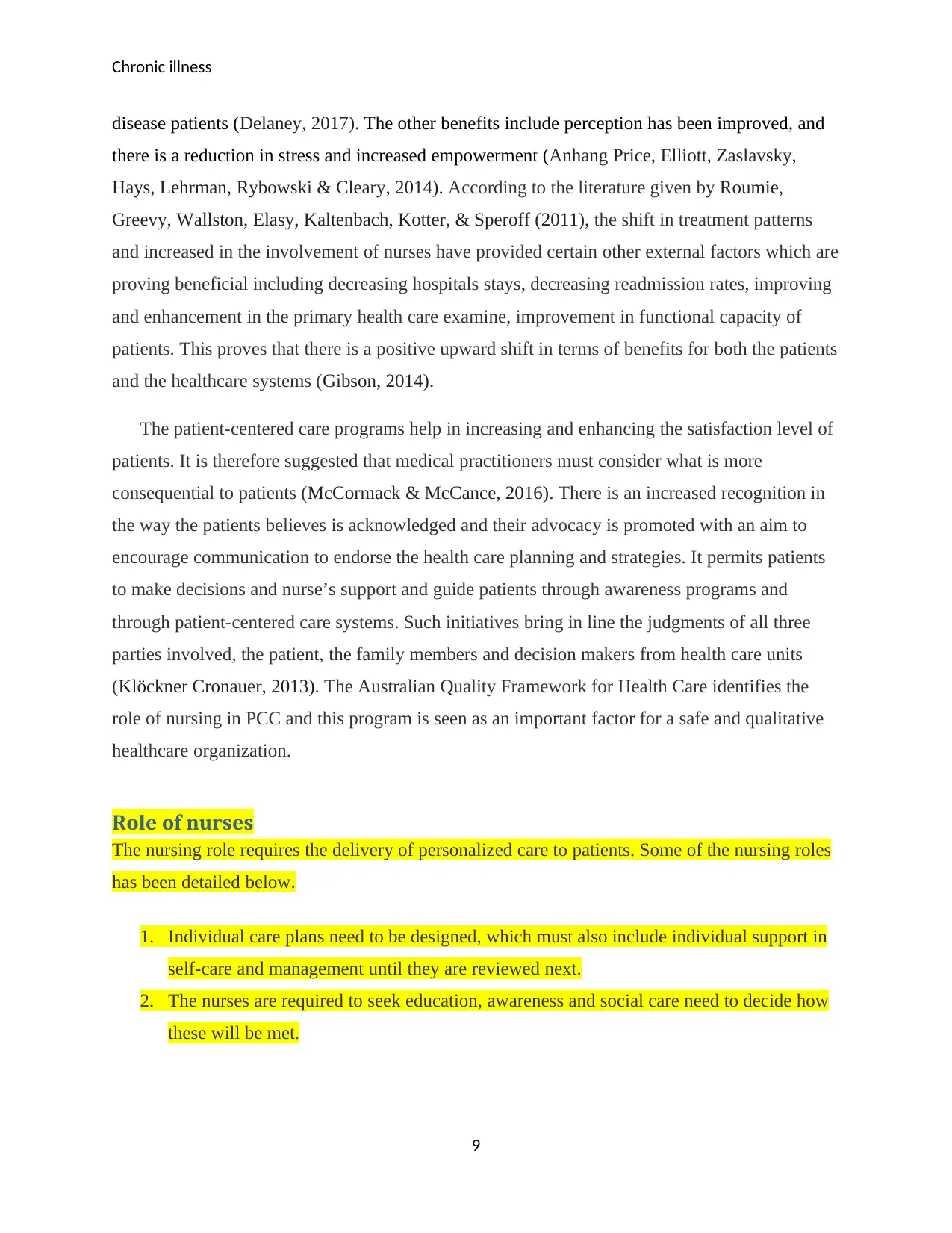
Chronic illness
disease patients (Delaney, 2017). The other benefits include perception has been improved, and
there is a reduction in stress and increased empowerment (Anhang Price, Elliott, Zaslavsky,
Hays, Lehrman, Rybowski & Cleary, 2014). According to the literature given by Roumie,
Greevy, Wallston, Elasy, Kaltenbach, Kotter, & Speroff (2011), the shift in treatment patterns
and increased in the involvement of nurses have provided certain other external factors which are
proving beneficial including decreasing hospitals stays, decreasing readmission rates, improving
and enhancement in the primary health care examine, improvement in functional capacity of
patients. This proves that there is a positive upward shift in terms of benefits for both the patients
and the healthcare systems (Gibson, 2014).
The patient-centered care programs help in increasing and enhancing the satisfaction level of
patients. It is therefore suggested that medical practitioners must consider what is more
consequential to patients (McCormack & McCance, 2016). There is an increased recognition in
the way the patients believes is acknowledged and their advocacy is promoted with an aim to
encourage communication to endorse the health care planning and strategies. It permits patients
to make decisions and nurse’s support and guide patients through awareness programs and
through patient-centered care systems. Such initiatives bring in line the judgments of all three
parties involved, the patient, the family members and decision makers from health care units
(Klöckner Cronauer, 2013). The Australian Quality Framework for Health Care identifies the
role of nursing in PCC and this program is seen as an important factor for a safe and qualitative
healthcare organization.
Role of nurses
The nursing role requires the delivery of personalized care to patients. Some of the nursing roles
has been detailed below.
1. Individual care plans need to be designed, which must also include individual support in
self-care and management until they are reviewed next.
2. The nurses are required to seek education, awareness and social care need to decide how
these will be met.
9
disease patients (Delaney, 2017). The other benefits include perception has been improved, and
there is a reduction in stress and increased empowerment (Anhang Price, Elliott, Zaslavsky,
Hays, Lehrman, Rybowski & Cleary, 2014). According to the literature given by Roumie,
Greevy, Wallston, Elasy, Kaltenbach, Kotter, & Speroff (2011), the shift in treatment patterns
and increased in the involvement of nurses have provided certain other external factors which are
proving beneficial including decreasing hospitals stays, decreasing readmission rates, improving
and enhancement in the primary health care examine, improvement in functional capacity of
patients. This proves that there is a positive upward shift in terms of benefits for both the patients
and the healthcare systems (Gibson, 2014).
The patient-centered care programs help in increasing and enhancing the satisfaction level of
patients. It is therefore suggested that medical practitioners must consider what is more
consequential to patients (McCormack & McCance, 2016). There is an increased recognition in
the way the patients believes is acknowledged and their advocacy is promoted with an aim to
encourage communication to endorse the health care planning and strategies. It permits patients
to make decisions and nurse’s support and guide patients through awareness programs and
through patient-centered care systems. Such initiatives bring in line the judgments of all three
parties involved, the patient, the family members and decision makers from health care units
(Klöckner Cronauer, 2013). The Australian Quality Framework for Health Care identifies the
role of nursing in PCC and this program is seen as an important factor for a safe and qualitative
healthcare organization.
Role of nurses
The nursing role requires the delivery of personalized care to patients. Some of the nursing roles
has been detailed below.
1. Individual care plans need to be designed, which must also include individual support in
self-care and management until they are reviewed next.
2. The nurses are required to seek education, awareness and social care need to decide how
these will be met.
9
⊘ This is a preview!⊘
Do you want full access?
Subscribe today to unlock all pages.

Trusted by 1+ million students worldwide
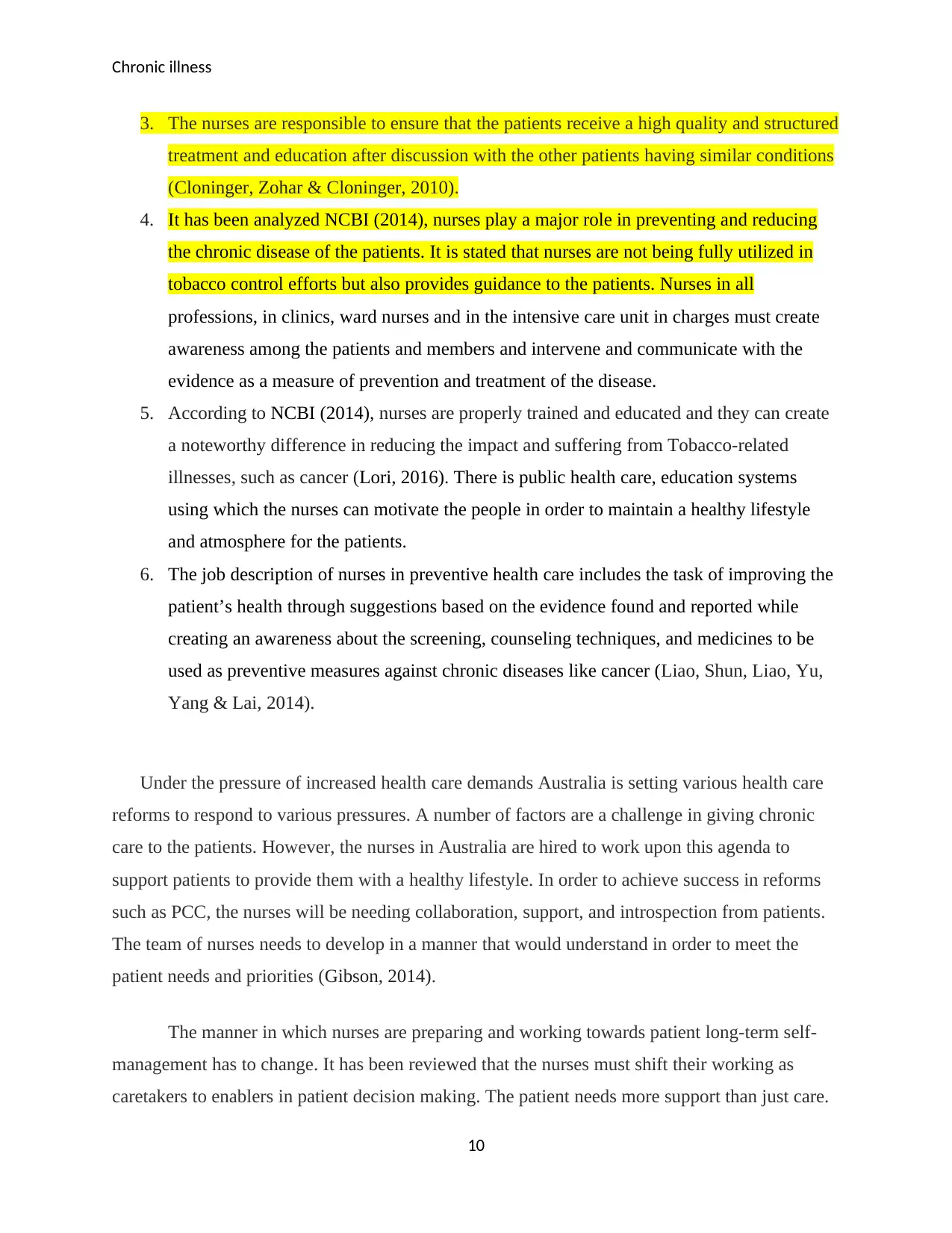
Chronic illness
3. The nurses are responsible to ensure that the patients receive a high quality and structured
treatment and education after discussion with the other patients having similar conditions
(Cloninger, Zohar & Cloninger, 2010).
4. It has been analyzed NCBI (2014), nurses play a major role in preventing and reducing
the chronic disease of the patients. It is stated that nurses are not being fully utilized in
tobacco control efforts but also provides guidance to the patients. Nurses in all
professions, in clinics, ward nurses and in the intensive care unit in charges must create
awareness among the patients and members and intervene and communicate with the
evidence as a measure of prevention and treatment of the disease.
5. According to NCBI (2014), nurses are properly trained and educated and they can create
a noteworthy difference in reducing the impact and suffering from Tobacco-related
illnesses, such as cancer (Lori, 2016). There is public health care, education systems
using which the nurses can motivate the people in order to maintain a healthy lifestyle
and atmosphere for the patients.
6. The job description of nurses in preventive health care includes the task of improving the
patient’s health through suggestions based on the evidence found and reported while
creating an awareness about the screening, counseling techniques, and medicines to be
used as preventive measures against chronic diseases like cancer (Liao, Shun, Liao, Yu,
Yang & Lai, 2014).
Under the pressure of increased health care demands Australia is setting various health care
reforms to respond to various pressures. A number of factors are a challenge in giving chronic
care to the patients. However, the nurses in Australia are hired to work upon this agenda to
support patients to provide them with a healthy lifestyle. In order to achieve success in reforms
such as PCC, the nurses will be needing collaboration, support, and introspection from patients.
The team of nurses needs to develop in a manner that would understand in order to meet the
patient needs and priorities (Gibson, 2014).
The manner in which nurses are preparing and working towards patient long-term self-
management has to change. It has been reviewed that the nurses must shift their working as
caretakers to enablers in patient decision making. The patient needs more support than just care.
10
3. The nurses are responsible to ensure that the patients receive a high quality and structured
treatment and education after discussion with the other patients having similar conditions
(Cloninger, Zohar & Cloninger, 2010).
4. It has been analyzed NCBI (2014), nurses play a major role in preventing and reducing
the chronic disease of the patients. It is stated that nurses are not being fully utilized in
tobacco control efforts but also provides guidance to the patients. Nurses in all
professions, in clinics, ward nurses and in the intensive care unit in charges must create
awareness among the patients and members and intervene and communicate with the
evidence as a measure of prevention and treatment of the disease.
5. According to NCBI (2014), nurses are properly trained and educated and they can create
a noteworthy difference in reducing the impact and suffering from Tobacco-related
illnesses, such as cancer (Lori, 2016). There is public health care, education systems
using which the nurses can motivate the people in order to maintain a healthy lifestyle
and atmosphere for the patients.
6. The job description of nurses in preventive health care includes the task of improving the
patient’s health through suggestions based on the evidence found and reported while
creating an awareness about the screening, counseling techniques, and medicines to be
used as preventive measures against chronic diseases like cancer (Liao, Shun, Liao, Yu,
Yang & Lai, 2014).
Under the pressure of increased health care demands Australia is setting various health care
reforms to respond to various pressures. A number of factors are a challenge in giving chronic
care to the patients. However, the nurses in Australia are hired to work upon this agenda to
support patients to provide them with a healthy lifestyle. In order to achieve success in reforms
such as PCC, the nurses will be needing collaboration, support, and introspection from patients.
The team of nurses needs to develop in a manner that would understand in order to meet the
patient needs and priorities (Gibson, 2014).
The manner in which nurses are preparing and working towards patient long-term self-
management has to change. It has been reviewed that the nurses must shift their working as
caretakers to enablers in patient decision making. The patient needs more support than just care.
10
Paraphrase This Document
Need a fresh take? Get an instant paraphrase of this document with our AI Paraphraser

Chronic illness
Further, nurses need to expand the patient’s competence together with empowering them, an
empowered patient is in a better position and is willing to alter their health behavior which is
imperative to self-management and improvement (Klöckner Cronauer, 2013). It is recommended
that policymakers and regulators must include person-centered care as a dimension of quality in
its own right in strategic policy documentation. The patient survey tools shall include a core and
unique set of items standardized at a national level to enable the collation and promote the
patient-centered care globally. Implementation of healthcare funding shall be done to improve
and reduce chronic illness in the global market. To enhance and improve the transparency, the
Australian regulators and policymakers must make data regarding patient care knowledge and
experience in the health of services.
It can be concluded from the above study that Patient-centered care requires an intensive
care by the nurses. PCC is imperative to patients and healthcare professionals. This program and
processes are followed by nurses and medical teams provide important insights in order to
provide the better partnerships among the patients, families and healthcare professionals and to
meet the personalized patient need, wants and desires. The healthcare service providers,
including the nurses, must make sure that the patients are given the best care, knowledge, and
information so that they are able to make significant decisions and the patients receive the
greatest support to improve their health and well being. An extensive research has been done to
identify and support the benefits of Patient-centric care and self-management. It has been
identified that such processes not only provide benefits to the patients but also the hospitals and
families as well. It also reduces reduced costs and readmissions and increases the life expectancy
rate. Therefore, it is concluded through this essay that if patients are given the right amount of
knowledge, education, and support on regular basis then they are capable of preventing further
health issues in chronic diseases. They are also able to self-manage their lifestyle and assess their
own health status.
11
Further, nurses need to expand the patient’s competence together with empowering them, an
empowered patient is in a better position and is willing to alter their health behavior which is
imperative to self-management and improvement (Klöckner Cronauer, 2013). It is recommended
that policymakers and regulators must include person-centered care as a dimension of quality in
its own right in strategic policy documentation. The patient survey tools shall include a core and
unique set of items standardized at a national level to enable the collation and promote the
patient-centered care globally. Implementation of healthcare funding shall be done to improve
and reduce chronic illness in the global market. To enhance and improve the transparency, the
Australian regulators and policymakers must make data regarding patient care knowledge and
experience in the health of services.
It can be concluded from the above study that Patient-centered care requires an intensive
care by the nurses. PCC is imperative to patients and healthcare professionals. This program and
processes are followed by nurses and medical teams provide important insights in order to
provide the better partnerships among the patients, families and healthcare professionals and to
meet the personalized patient need, wants and desires. The healthcare service providers,
including the nurses, must make sure that the patients are given the best care, knowledge, and
information so that they are able to make significant decisions and the patients receive the
greatest support to improve their health and well being. An extensive research has been done to
identify and support the benefits of Patient-centric care and self-management. It has been
identified that such processes not only provide benefits to the patients but also the hospitals and
families as well. It also reduces reduced costs and readmissions and increases the life expectancy
rate. Therefore, it is concluded through this essay that if patients are given the right amount of
knowledge, education, and support on regular basis then they are capable of preventing further
health issues in chronic diseases. They are also able to self-manage their lifestyle and assess their
own health status.
11

Chronic illness
References
Alla. G., (2018). How does lung cancer impact the body [Online], retrieved from
https://www.sharecare.com/health/lung-cancer/how-impact-lung-cancer-body
Anhang Price, R., Elliott, M. N., Zaslavsky, A. M., Hays, R. D., Lehrman, W. G., Rybowski,
L., ... & Cleary, P. D. (2014). Examining the role of patient experience surveys in
measuring health care quality. Medical Care Research and Review, 71(5), 522-554.doi:
org/10.1177/1077558714541480
Australia institute of health and welfare.,(2018). Burden of disease [Online], Retrieved from
https://www.aihw.gov.au/reports-statistics/health-conditions-disability-deaths/burden-of-
disease/reports
Bardes, C. L. (2012). Defining “patient-centered medicine”. New England Journal of
Medicine, 366(9), 782-783.doi: 10.1056/NEJMp1200070
Bolster, D., & Manias, E. (2010). Person-centred interactions between nurses and patients during
medication activities in an acute hospital setting: qualitative observation and interview
study. International journal of nursing studies, 47(2), 154-165.doi:
org/10.1016/j.ijnurstu.2009.05.021
12
References
Alla. G., (2018). How does lung cancer impact the body [Online], retrieved from
https://www.sharecare.com/health/lung-cancer/how-impact-lung-cancer-body
Anhang Price, R., Elliott, M. N., Zaslavsky, A. M., Hays, R. D., Lehrman, W. G., Rybowski,
L., ... & Cleary, P. D. (2014). Examining the role of patient experience surveys in
measuring health care quality. Medical Care Research and Review, 71(5), 522-554.doi:
org/10.1177/1077558714541480
Australia institute of health and welfare.,(2018). Burden of disease [Online], Retrieved from
https://www.aihw.gov.au/reports-statistics/health-conditions-disability-deaths/burden-of-
disease/reports
Bardes, C. L. (2012). Defining “patient-centered medicine”. New England Journal of
Medicine, 366(9), 782-783.doi: 10.1056/NEJMp1200070
Bolster, D., & Manias, E. (2010). Person-centred interactions between nurses and patients during
medication activities in an acute hospital setting: qualitative observation and interview
study. International journal of nursing studies, 47(2), 154-165.doi:
org/10.1016/j.ijnurstu.2009.05.021
12
⊘ This is a preview!⊘
Do you want full access?
Subscribe today to unlock all pages.

Trusted by 1+ million students worldwide
1 out of 15
Related Documents
Your All-in-One AI-Powered Toolkit for Academic Success.
+13062052269
info@desklib.com
Available 24*7 on WhatsApp / Email
![[object Object]](/_next/static/media/star-bottom.7253800d.svg)
Unlock your academic potential
Copyright © 2020–2026 A2Z Services. All Rights Reserved. Developed and managed by ZUCOL.





